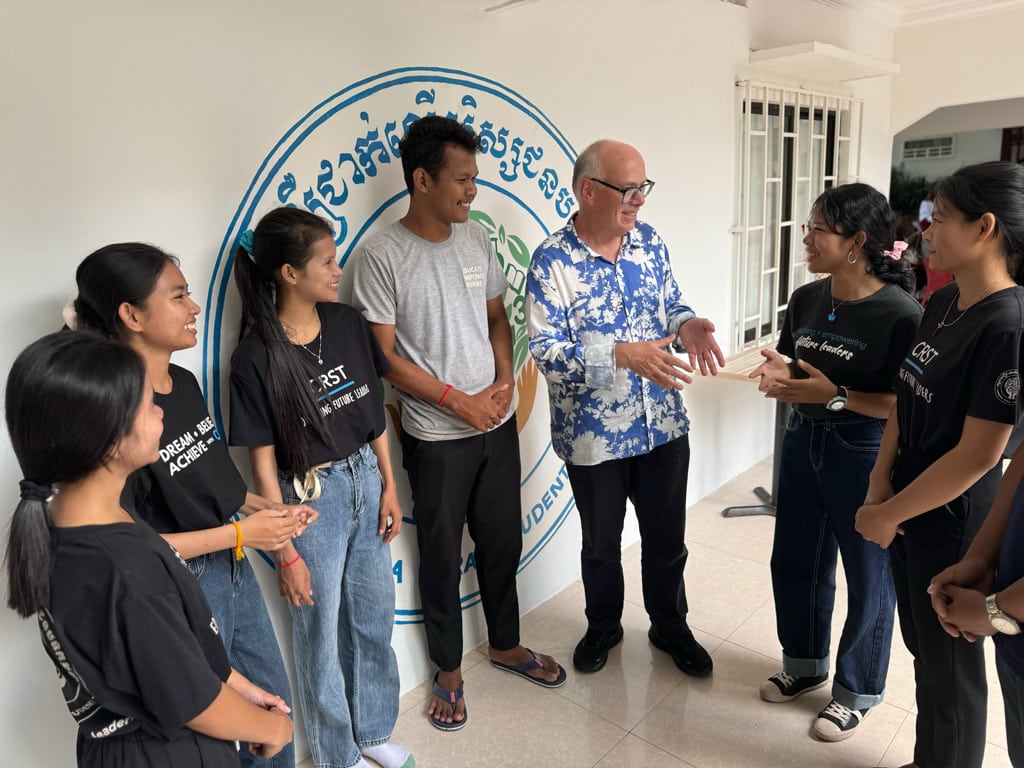What does sustainable development look like?

In 2009, our 14-year-old daughter, Steph, was denied a life-changing school trip to Cambodia to volunteer with disadvantaged rural families. We decided to embrace the opportunity and travelled to Cambodia as a family, volunteering to teach English at a rural school in Siem Reap province. Those two weeks changed the course of our lives, and the lives of thousands of rural Cambodian students and their families. Our students were all the children of survivors of the Khmer Rouge regime and the ensuing civil war – while their parents were illiterate, they understood the value and importance of education. We returned to volunteer in Cambodia several more times and in 2011 founded the Cambodia Rural Students Trust NGO (CRST); with the vision of educating future leaders, our organisation’s core values include accountability, transparency and sustainability.
CRST is unique because it’s entirely led and managed by our students. We teach them that as Cambodia’s future leaders, it’s their responsibility to contribute to the sustainable development of their country. Through formal education, extensive mentoring and the opportunities to gain hands-on practical skills, the students of CRST also lead and manage sustainable development projects in areas as diverse as women’s empowerment, energy poverty, social inequity and environmental degradation, reaching thousands of beneficiaries annually.
The roles of individuals and communities
Sustainable development is a collective effort, with individuals and communities playing a critical role. Building inclusive societies ensures that everyone has access to healthcare, education, and employment. Social sustainability also promotes equality, diversity, and community cohesion.
Educating younger generations about sustainable development ensures environmental and social responsibility for the future. We teach our CRST students that their education and mentorship opportunities are not just for their own benefit, but also a powerful way to uplift others. By empowering themselves, they inspire younger generations, creating a far-reaching ripple effect. This collective effort raises the tide for countless rural students, building a legacy of hope and opportunity, transforming lives and shaping a brighter future for all.
The sustainable development impact we are creating is far and wide as our university students become inspirational role models for over 20,000 rural students in Cambodia every year, leading and managing our sustainable development Projects –
- The Project B – Bicycles for Education team distribute and repair over 1000 bicycles for rural students each year, supporting their continued schooling, reducing environmental impact and enabling them to become greater social contributors in the future.
- Project G – Empowering girls educates over 7000 rural students each year about gender equality, distributing more than 5000 beautiful and reusable menstruation kits to rural high school girls, supporting education and leading to sustainable social contributions.
- The Project L- Light for Education team distribute over 3000 SolarBuddy study lights and study-material kits annually to remote students living in energy poverty, supporting the environment and economic development.
- Project T – Trees for Life plants over 5000 trees every year in both rural and urban settings, supporting a greener and healthier environment for all.
- Our Project W – WASH for Education team is managing the installation of biosand water filtration systems, toilets and incinerators at more than 20 rural schools this year, impacting thousands of students and community members, bringing sustainable development to disadvantaged and remote communities.
Sustainable development offers a vision of progress that does not compromise the environment or social cohesion. Embracing sustainable development is more than an ethical choice; it’s a chance to lead by example, showing how growth can be responsible and inclusive. By aligning government, industry, and community efforts, societies can create a legacy of sustainability for future generations to benefit from and take pride in.
Written by Aviv Palti.
Have you read?
Most Powerful Currencies In The World.
The world’s largest cities by population.
Most Innovative Countries in the World.
Countries by Average Wealth per Person.
Bring the best of the CEOWORLD magazine's global journalism to audiences in the United States and around the world. - Add CEOWORLD magazine to your Google News feed.
Follow CEOWORLD magazine headlines on: Google News, LinkedIn, Twitter, and Facebook.
Copyright 2025 The CEOWORLD magazine. All rights reserved. This material (and any extract from it) must not be copied, redistributed or placed on any website, without CEOWORLD magazine' prior written consent. For media queries, please contact: info@ceoworld.biz








